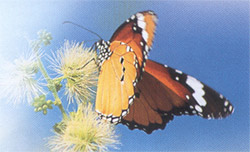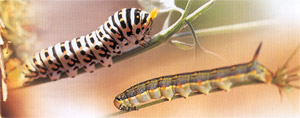|
In
a desert environment such as the UAE has,
most of the flowering plants are
pollinated by the wind. The flowers do not
need to attract pollinating insects and
therefore can be small and insignificant.
The butterflies that take care of
pollination in other regions do not have
such an important role to play here, so it
is not surprising that the number of
species is limited to less than forty.
It
could also be the other way around:
because the climate is hard to cope with
for a plant, it stays small with small
leaves and flowers, so as not to need
too much energy to complete a life-cycle
and to expose too much of its surface to
the heat of the sun. Because the flowers
are so insignificant, they do not
attract butterflies and rely on the wind
for their pollination.
Surprisingly, over 350 night-flying moths
have been identified in the UAE - almost
all by amateur enthusiasts. Not enough
study has been done to establish the role
of these insects in the ecology of the
desert. Of some it is known that their
caterpillars can be harmful to
agricultural or horticultural
developments. Many may be essential in
pollinating wild plants as well as
agricultural crops. Only about half a
dozen of the moths are day-flying, and
these are the ones we can encounter in
gardens, plantations or fields with wild
vegetation. At least one of these
inconspicuous small moths has a
caterpillar that has an unusual defense
strategy. It gathers little pieces of
straw and builds a little house around its
body. From the safety of this unusual
armour it crawls around the bushes on
which it feeds.
 By far
the most spectacular of the moths are the
Death Head Hawkmoth (Acherontos styx)
and the Oleander Hawkmoth. (Daphnis
nerii). Both have a wingspan of up to
10 cm. The Death Head Hawkmoth gets its
name from a peculiar marking on the back
of its brown thorax in the form of a pale
yellow skull. The wings are velvety brown
but the abdomen is striped in yellow and
brown. It has a sweet tooth and likes to
raid the honeycombs of the local bees for
honey. In order to get to the honey
without being murdered by the defending
bees, it has learned to make the same
sound that honey-carrying bees make when
they return to the hive. This noise means:
"I am not an enemy, do not attack me".
Most of the time the moth get away with
this ruse, but sometimes the bees are not
fooled and dead Death Head Hawkmoths can
be found on the ground underneath a
beehive. By far
the most spectacular of the moths are the
Death Head Hawkmoth (Acherontos styx)
and the Oleander Hawkmoth. (Daphnis
nerii). Both have a wingspan of up to
10 cm. The Death Head Hawkmoth gets its
name from a peculiar marking on the back
of its brown thorax in the form of a pale
yellow skull. The wings are velvety brown
but the abdomen is striped in yellow and
brown. It has a sweet tooth and likes to
raid the honeycombs of the local bees for
honey. In order to get to the honey
without being murdered by the defending
bees, it has learned to make the same
sound that honey-carrying bees make when
they return to the hive. This noise means:
"I am not an enemy, do not attack me".
Most of the time the moth get away with
this ruse, but sometimes the bees are not
fooled and dead Death Head Hawkmoths can
be found on the ground underneath a
beehive.
The
Oleander Hawkmoth gets its name from the
fact that its caterpillars feed on
oleander leaves. The moth is beautifully
marked with "camouflage" colours and
shapes, in olive green, pink and greyish-brown.
The caterpillar is also quite spectacular:
a finger-thick, fleshy larva, bright green
with yellow spots on its sides. When the
caterpillar is startled by a would-be
attacker, it bends its head down quickly,
exposing two large shimmering blue eyes on
the back of its neck. The enormous eyes
scare off the attacker by their size and
sudden appearance. You can evoke this
threat posture by touching the branch on
which the caterpillar is feeding.
Although
most of the moths are rarely seen, since
they only fly at night, their caterpillars
are found more easily and these are often
spectacular in their colour. They can
always be recognised as hawkmoth
caterpillars by the horn on the back of
their bodies.
The most
common day-flying moth in the UAE is a
small, fast-flying insect that I called
the "Polkadot moth" when I first saw it,
but its proper English name is
"Crimson-speckled footman" (Utetheisa
pulchella). The caterpillar is
incredibly beautiful: a silver-coloured
body with black, red and white stripes and
spots. These black and red colours also
appear as spots on the moth's white wings.
Even though these spots are very bright,
they serve as camouflage. As soon as the
moth settles on sand or vegetation, it
seems to disappear, and if you did not see
where it settled, you will never spot it
again.
Several
smaller species of Hawkmoths occur in the
UAE. They all have rather wonderful
caterpillars, each with a large "horn" on
the rear end of their bodies. My personal
favourite is the Hummingbird hawkmoth,
that hovers in front of flowers, "standing
still" in the air with its tongue
protruding to get nectar. It is a rather
rare insect, recorded from Wadi Bih.
 Moths
can be distinguished from butterflies by
the way they hold their wings. In moths
the wings are folded against the body when
resting. In butterflies the wings are
either spread out sideways or folded above
their backs. Moths
can be distinguished from butterflies by
the way they hold their wings. In moths
the wings are folded against the body when
resting. In butterflies the wings are
either spread out sideways or folded above
their backs.
The
largest butterflies that are commonly seen
are the Swallowtails. There are two
species of representing the Papilio
genus here: the common Papilio demoleus
and the somewhat the more rare Papilio
machaon. Both can be found flying
around in city gardens and in palm groves
that have citrus trees among the
undergrowth. Often butterflies like the
Swallowtails (and also the smaller
Monarchs) can be found on patches of damp
soil, where they appear to be drinking.
But if you observe them carefully, you can
see that they loose drops of moisture from
the back of their abdomen quite steadily.
They are not actually drinking but
filtering water to take out minerals and
trace elements that they need.
Smaller
butterflies that are found commonly, both
in gardens and in the desert are the
Painted Lady (Vanessa or Cynthia
cardui) and the Plain Tiger (Danaus
chrisyppus). The Painted Lady is a
delicately marked butterfly that can be
found often on flowering Ochradenus
aucheri bushes. The latter genus -
also called the Monarch - is one that is
widespread throughout the world. It is a
strong migrant and can cover enormous
distances each year. One of the Monarch
species (Danaus plexipus) is very
famous because it migrates each year from
North America to one patch of forest in
Mexico, where millions of the butterflies
spend the winter hanging on the branches
of the trees, sometimes breaking them
under the weight of their numerous bodies!
This patch of woods has recently been made
into a world heritage nature reserve, and
rightly so!
Danaus
chrysippus
is one of the most common butterflies in
the UAE. Its caterpillars feed on plants
that exude poisonous milky saps, the
Asclepediaceae, such as the
Pergularia tomentosa, Calotropis
procera and others. As a result of the
poisonous sap that the larva ingests, the
butterfly becomes unpalatable to birds.
Its bright orange black and white
colouring serves as a warning to the
birds: "Don't eat me, I taste horrible"
Another food plant is the wild carrot. The
caterpillars that feed on these plants
have an interesting defense mechanism.
When disturbed or attacked, they bend
their heads in the threat posture and
quickly extend two yellow appendages that
emit a strong smell of carrot.
Again,
there is something interesting here.
Another butterfly, common in East Coast
plantations, is the Diadem. It has
developed a defense mechanism against
becoming the prey for birds. While the
male Diadem is conspicuously black with
white patches, ringed with iridescent
blue, the female does not resemble its
male at all. In fact, it is almost
identical to the Plain Tiger. The only
difference is that it is slightly larger
and that it has only one black spot on its
hind wings, instead of four. By taking on
the colouration of the Plain Tiger, it
advertises to birds that it is
unpalatable, while in fact it does not
taste bad at all. The Diadem butterfly is
much more rare than the Plain Tiger, so
most orange/black/white butterflies that
you see will be the latter.
Some
butterflies that are true desert insects
are the Desert White (Anaphis aurota),
the Blue Pansy (Junonia orithiya)
and the White-edged Rock Brown (Hipparchia
parisatis). The Desert White is a
common visitor of the spring ephemeral
flowers, while the Blue Pansy can be found
throughout the cooler months.
Interestingly, the White-edged Rock Brown
even stays around in the hot months of
summer, finding refuge from the high
temperatures in caves and under
overhanging rocks, where at times they
will roost by the hundreds.
Some
plants attract butterflies more than
others. One small butterfly, the
Blue-spotted Arab (Colotis phisadia),
can be found in large swarms feeding on
the flowers of the toothbrush bush
Salvadora persica, and of
Dipterigium glaucum, a member of the
Caper family.
The
smallest butterflies belong to the family
of the Little Blues. There are many
different species in this family, with
lovely names like Mediterranean Pierrot
and Small Cupid. Though they are small,
they are quite spectacular when seen
through the macrolens. The upper side is
bright sky-blue, while the underside is
usually gray with a number of iridescent
rings along the edges of the lower wings.
Many have small appendages on the lower
wings.
The very
rare Fig Blue butterfly has very long
appendages on its lower wings. This much
larger butterfly can sometimes be found on
Oleander bushes in the wadis.
The smallest
of the small butterflies is the Grass
Jewel, a tiny brown insect, common in
plantations and vegetated wadis. Its
wingspan is less than 1 cm.
There have been new "imports" into the
country; one noticeably has made its way
to the UAE from as far as America. It is a
very small, but very beautiful butterfly
that can be observed in large numbers
around the Sesuvium verrucosum
plants that grow profusely on the dumpsite
near the American University of Sharjah.
With the vegetation in the UAE ever
increasing and international transport
inadvertently importing insects from other
parts of the world, new species may well
be added to the ones recorded for the UAE
so far.

|
